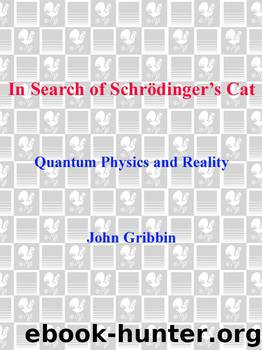In Search of Schrodinger's Cat by John Gribbin

Author:John Gribbin [Gribbin, John]
Language: eng
Format: epub, mobi
ISBN: 9780307790446
Publisher: Random House Publishing Group
Published: 2011-05-04T04:00:00+00:00
SUPERCONDUCTORS
Like semiconductors, superconductors have a logical name. A superconductor is a material that conducts electricity without any apparent resistance at all. This is as close as we are ever likely to get to perpetual motion—it isn’t quite something for nothing, but it is a rare example of actually getting everything you pay for in physics, without being short changed. And it can be explained by a change that makes pairs of electrons associate with one another and move together. Although each electron has half-integer spin, and therefore obeys Fermi-Dirac statistics and the exclusion principle, a pair of electrons can behave in some circumstances as a single particle with integer spin. Such a particle is not constrained by the exclusion principle, and obeys the same Bose-Einstein statistics that describe, in quantum mechanical terms, the behavior of photons.
The Dutch physicist Kamerlingh Onnes discovered superconductivity in 1911, when he found that mercury lost all its electrical resistance when cooled to below 4.2 degrees on the absolute temperature scale (4.2 degrees K, or about –269 degrees C). Onnes got the Nobel Prize for his low-temperature work in 1913, but this was for other work, notably the preparation of liquid helium, and the phenomenon of superconductivity wasn’t satisfactorily explained until 1957, when John Bardeen, Leon Cooper, and Robert Schrieffer came up with a theory that earned them the Nobel Prize in Physics in 1972.* The explanation depends on the way paired electrons interact with atoms in a crystal lattice. One electron interacts with the crystal, and as a result of this interaction the interaction of the crystal with the other electron in the pair is modified. So, in spite of their natural tendency to repel one another, the pair of electrons forms a loosely bound association, sufficient to account for the change from Fermi-Dirac to Bose-Einstein statistics. Not all materials can become superconducters, and even in those that can any small disturbance from the thermal vibrations of atoms in the crystal will break up the electron pairing, which is why the phenomenon only occurs at very low temperatures, in the range 1 to 10K. Below some critical temperature, which varies from one material to another but is always the same for the same substance, some materials become superconductors; above that temperature, the electron pairing is broken and they have normal electrical properties.
The theory is borne out by the fact that materials that are good conductors at room temperature are not the best superconductors. A good “normal” conductor allows electrons to move freely precisely because they do not interact very much with the atoms in the crystal lattice—yet without an interaction between the electrons and the atoms there is no way for the electron coupling that leads to superconductivity to be effective at low temperatures.
Download
In Search of Schrodinger's Cat by John Gribbin.mobi
This site does not store any files on its server. We only index and link to content provided by other sites. Please contact the content providers to delete copyright contents if any and email us, we'll remove relevant links or contents immediately.
The Complete Stick Figure Physics Tutorials by Allen Sarah(7310)
Secrets of Antigravity Propulsion: Tesla, UFOs, and Classified Aerospace Technology by Ph.D. Paul A. Laviolette(5310)
Thing Explainer by Randall Munroe(3877)
The River of Consciousness by Oliver Sacks(3542)
The Order of Time by Carlo Rovelli(3145)
How To by Randall Munroe(3036)
A Brief History of Time by Stephen Hawking(2962)
I Live in the Future & Here's How It Works by Nick Bilton(2938)
The Great Unknown by Marcus du Sautoy(2648)
What If?: Serious Scientific Answers to Absurd Hypothetical Questions by Randall Munroe(2637)
Midnight in Chernobyl by Adam Higginbotham(2483)
Blockchain: Ultimate Step By Step Guide To Understanding Blockchain Technology, Bitcoin Creation, and the future of Money (Novice to Expert) by Keizer Söze(2450)
Networks: An Introduction by Newman Mark(2360)
The Meaning of it All by Richard Feynman(2300)
Easy Electronics by Charles Platt(2282)
The Tao of Physics by Fritjof Capra(2231)
Midnight in Chernobyl: The Untold Story of the World's Greatest Nuclear Disaster by Adam Higginbotham(2177)
When by Daniel H Pink(2083)
Introducing Relativity by Bruce Bassett(2080)
